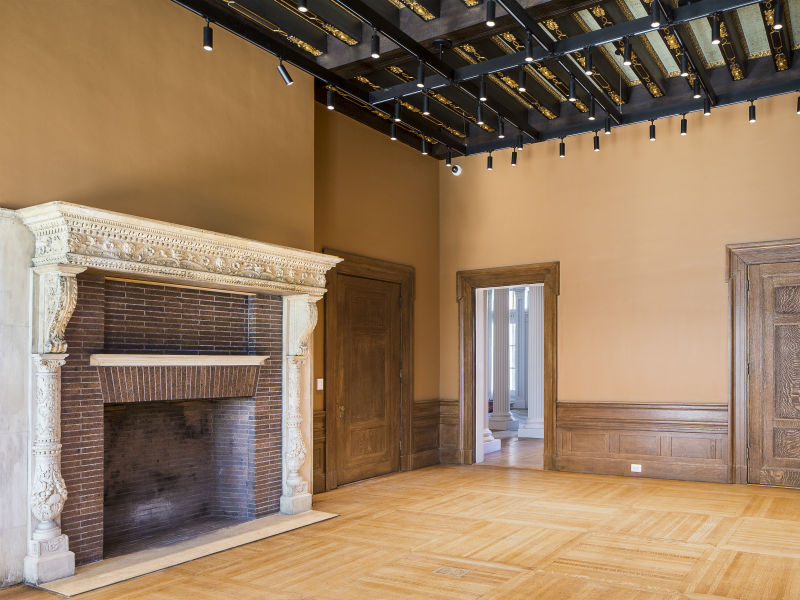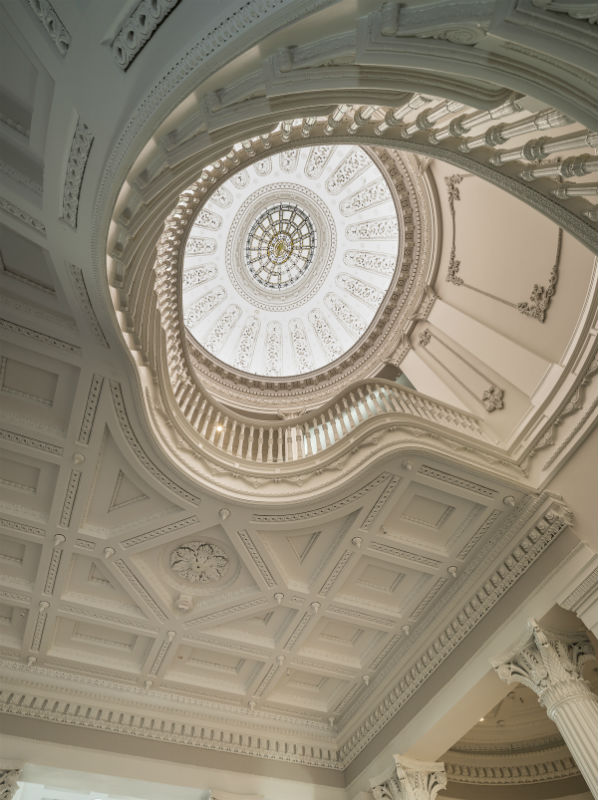Led by Lewis Contractors, a team of experts and artisans recently worked on a detailed restoration project at the historic Hackerman House of The Walters Art Museum in Baltimore City. For their extraordinary efforts to protect the building’s historic interior and impressive art collection, Preervation Maryland will recognize those involved with a Best of Maryland award.
FROM THE AWARD NOMINATION
SUBMITTED BY LEWIS CONTRACTORS
At the direction of The Walters Art Museum, the Hackerman House — a Greek revival and former home of Dr. John Hanson Thomas — and its former garden and carriage house have been sensitively restored to highlight not only the artwork which will be displayed within, but also the home itself. Originally constructed in 1850 as the first home at Mount Vernon Place, Hackerman House remained continuously occupied until it was gifted to the Walters Art Museum in 1984. Together, the Executive Director and the Board of the Directors hired Lewis Contractors to complete what is only the second major renovation in the home’s history.
Congratulate the artisans, Lewis Contractors, and The Walters Art Museum, at the Best of Maryland preservation awards event on Thursday, May 17, 2018 at The Star-Spangled Banner Flag House in Baltimore City. Celebrate with us and explore The Flag House with people that love Maryland as much as you do!
Once re-opened, the renovated mansion can be rightfully described as not just a gallery which houses art from The Walters’ collection, but as an actual piece of art itself. Visitors’ attention will be drawn to art hung on the walls and displayed in cases, as well as to the outstanding restored details of one of Baltimore’s most historic mansions. Less apparent to visitors will be the mechanical, electrical, and plumbing systems upgrade—including a state of the art water mist system—designed to protect the Museum’s collection.
The new water mist fire suppression system and the Vesda early fire detection system are intentionally so unobtrusive that few will notice them. Because of the careful oversight by the Maryland Historic Trust that holds an easement on the property of this restoration — every nozzle and monitor had to be precisely located on site. Approved shop drawings which generally detail the exact work on a construction project provided only general locations for the installation of the nozzles and monitors. In addition, because 19th century structures were coated in lead-based paint on all walls, ceilings and trim, every hole drilled into the building had to be completed using proper lead paint removal standards—(i.e. under containment, by trained workers in respirators wearing disposable clothing). This new Ultra Fog water mist fire suppression system had previously been used only in the container shipping industry and only in Europe—as a result, all the materials were shipped from the UK, and had to be totally adapted for use an architectural building—much less a historic one. Receiving approval of the system installation was a process that took several months.

The Ultra Fog system is held at a pressure of 1,000 PSI which increases to 3,800 PSI during a fire. Once a fire is detected, nozzles located unobtrusively in the ceiling emit a vapor-like mist which smothers a fire without substantially damaging the artwork or building structure. To meet state requirements, all of the piping, conduits, controls and materials for both the Ultra Fog and Vesda fire detection systems—and their associated electrical work had to be hidden to the greatest extent possible and can only be observed in the most modest closets throughout the house.
Installing the Ultra Fog and Vespa systems as well as new lighting for the Tiffany lay light—a grand detail within the ornate three story foyer—required that the area be scaffolded for workmen to reach the ceiling. No scaffold materials were permitted to touch the railing or highly ornamented walls. Materials were hoisted by hand, installed within walls positive with lead paint, and under full confinement. Of note, there was no damage to any of the walls or plaster ornamentation in the process of completing this work.
Another major aspect of the renovation included the completely rebuilt conservatory. Here, only the marble floor and roof structure were salvageable. By using as much salvaged material as possible, and matching the historic construction with new materials, thermal efficiencies have been enhanced exponentially.
Other parts of the renovation included removal and repair, or replication of the historic cast iron antefix ornaments at both roofs; in situ renovation of the cast iron window pediments; removal and replacement of the storm windows; demo and installation of new roofs at the main house, bay window and conservatory; removal, refurbishment and re-installation of the historic cast iron security grates and spandrel grilles; repairs to the chimneys; and removal, renovation and relocation of the wood floor finishes in the first and second floor gallery spaces.

Interior of the Hackerman House, The Walters Art Museum, 2017. Photo from Lewis Contractors.
During the restoration, removal of the old carpet frequently revealed that the historic wood flooring had been compromised by glue, nails, or even light weight concrete topping which necessitated removal and cataloging of the historic wood, as well as refinishing after re-installation. Where the fire suppression, Versa, or electrical installation penetrated the ceiling of the first floor, both the finished wood flooring and its sub floor had to be removed, repaired and later reinstalled.
The Museum required that many of the doors be refurbished and several were shown to be replaced. Fortunately, many historic doors were discovered by Lewis Contractors staff in the basement of another nearby Walters’ building, thereby saving thousands of dollars to reproduce historically accurate materials.
This magnificent mansion also revealed many of its secrets throughout the restoration, including the fact that the wall and pocket doors on the first floor were not original to the structure—evidenced by the original plaster ornamentation which became visible only after the pocket doors had been removed. Similarly, two restored windows revealed previously unknown messages scratched into the historic glass and removal of upholstered wall panels revealed hand crafted woodwork which had been hidden for decades.
Closed since summer of 2014, the mansion is planned to re-open in late spring 2018 and the renovated John and Berthe Ford Gallery will reopen later the same year. The renovations to the Ford Gallery were added to Lewis’ contract without increase to the project schedule.
The Walters Art Museum’s restoration of historic Mt. Vernon Place’s first residence is the most recent project to bring new attention to one of Baltimore’s most beautiful districts. This project followed Lewis Contractors’ restoration of the Peabody Library and book-ends the firm’s nationally recognized restoration of the Washington Monument.
THE ARTISANS
Fireline Corporation
The Fireline Corporation furnished and installed the fire alarm, fire detection and modern water mist fire suppression system — the first Ultrafog system installed in the United States. A standard fire alarm system was installed along with a modern Vesda system that uses constant air sampling to detect the minuscule amounts of smoke produced by fire. The water suppression system using high pressure pumps, line and heads to vaporize the water into the air which is drawn into the fire thence extinguishing said fire. Numerous lines, distribution blocks and heads need to be concealed and not to disturb the historic elements of the building and still meet today’s modern fire codes.
MasterCare Flooring
Contractors from MasterCare repaired wood flooring on the first floor and disassembled the flooring on the second floor to be cataloged and stored offsite is climate controlled area until both floors could be reassembled and finished.
Ariosa & Company
Ariosa & Company installed an all new HVAC system in two mechanical rooms on different floors, that together, allow all areas of the House to be carefully controlled for future art exhibits — all while concealing the duct work and not altering the historic appearance of the room.
Ruff Roofers
A team from Ruff Roofers recreated the historic configuration of the Hackerman House roof eaves and built-in gutter system.
Worcester Eisenbrandt, Inc.
- Carpenters from Worcester Eisenbrandt led and completed the restoration of the Conservatory, including salvaging and reusing as much of the historic elements including both structural and decorative wood work.
- On the exterior, carpenters from Worcester Eisenbrandt repaired and repainted the historic cornice and many historic windows and storm windows – retaining as much of the original fabric as possible.
- Masons from Worcester Eisenbrandt led the repair and rebuilding of four of the Hackerman House chimneys, including using salvaged brick with a historically-correct mortar.
- Stone masons from Worcester Eisenbrandt worked along the building’s watertable to hand select and cut replacement stones to repair the ground floor masonry; this included hand cut Dutchman and historically-correct mortar.
Hayles & Howe
Artisans from Hayles & Howe, patched numerous defects in the historic plaster walls and ceilings and skillfully created new plaster decorative elements that were missing based on existing evidence.
Cypress Painting Systems
A team from Cypress Painting used appropriate methods to remove old failing paint from the cast iron ornamental window pediments and pilasters before repainting. Interior walls, ceilings, and ornaments were also repainted.

